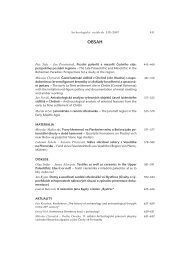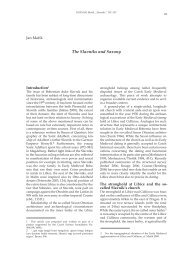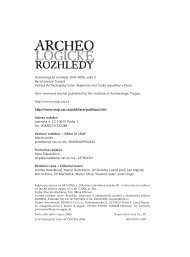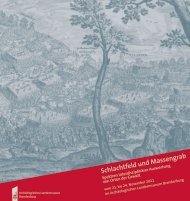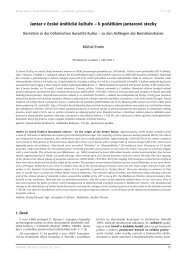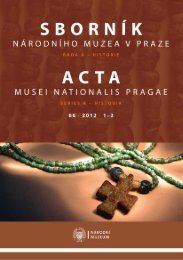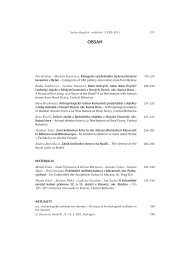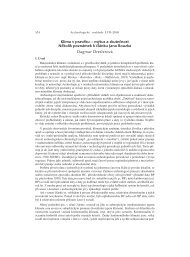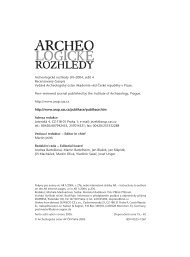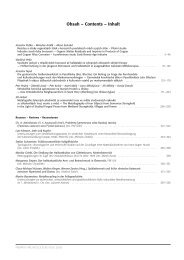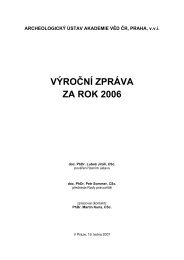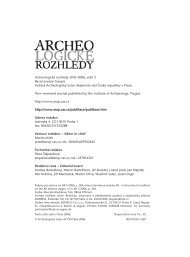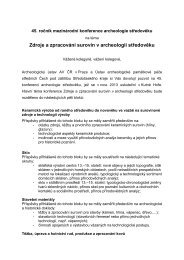Archeologické rozhledy 2009 - Archeologický ústav AV ČR
Archeologické rozhledy 2009 - Archeologický ústav AV ČR
Archeologické rozhledy 2009 - Archeologický ústav AV ČR
You also want an ePaper? Increase the reach of your titles
YUMPU automatically turns print PDFs into web optimized ePapers that Google loves.
30KVùTINA –KVùTINOVÁ –¤ÍDK¯: V˘znam her v archaick˘ch spoleãnostech …An example of a cultural space, for which the importance of games is supported even in the prehistoricalperiod, is Mesoamerica. From an archaeological viewpoint, what is interesting is bothlocal development of the formal form of courts for the ball game, from the early formative period(1600–1200 BC) basically to the present day, and also the interpretation of the significance of thisgame in the context of Mesoamerican society. JDP courts occur in the territory of Mesoamerica,the Southwest USA and the Carribean (fig. 9) – to date, approximately 1,500 of these structures havebeen discovered at approximately 1,250 locations. Based on a combination of the lengthwise andcrosswise profile, 11 basic types of court have been distinguished, as well as others for the peripheralareas. A chronological classification is attributed to the various types from the simplest pre-classicalto complicated, structured post-classical forms. Thanks to surviving iconographical and literarysources, information concerning the socio-political and symbolic function of the JDP fields, whichcould illuminate their almost universal occurrence (or occasional absence) in the Mesoamerican area,is available. JDP was a means to obtain power and strengthen a leading position in society, it alsoperformed a political function during the centralisation of power (the less centres with a JDP court,the greater centralisation). Its religious aspects were no less important: the court was a sacred spacesymbolising a link with the underworld, and human sacrifices or blood self-sacrifices enabled thecontinuation of life on earth (fig. 12, 13). From the viewpoint of the game’s universality and ritual,and of its functions in society, JDP presented an inspirational interpretation model for the issue ofthe European Neolithic under scrutiny.The final comparison of the Late Neolithic rondel structures and juego de pelota courts is basedon the method of structural analogies, which focus on an analysis of known properties of a studiedartefact and their comparison with a selected analogical entity (archaeological, historical, ethnological,etc.). We applied the given method when comparing rondels and JDP courts (tab. 7), and theresults ascertained enable both types of compared entities to be regarded as being analogical, eventhrough – at the level of general formal characteristics – we would otherwise regard them as dissimilar.Both types of structures have:– An identical shape or similar ground plan as a part of the relevant group;– Similar basic construction elements;– Similar internal surface dimensions;– The internal space was empty;– Parallel entities may have existed within one settlement site;– They only occur in some (central) settlement sites.Based on the submitted functional model for the structures for JDP, it can therefore be assumedthat the rondel architecture performed a universally comprehensible and accepted function, such asa setting for a certain form of game, close to ritual in nature. This – regardless of its specific form –reflected competition for power and prestige, both at the level of individuals/groups within communities,and between individual settlements. The building and maintenance of a rondel also served asa community’s self-identification and confirmed its status regarding other locations: the presence ofa rondel could therefore be an attribute of the centralisation of power, prestige and perhaps even riches.It is possible to hypothesise that events taking place in connection with rondels also had connotationsother than secular ones, although monopoly communications (the “controlling” of the contact) withthe supernatural may evidently have corresponded to the power ambitions of their protagonists. Wetherefore argue that rondel architecture represented a means of a society’s socio-political developmentand a reflection of its religiosity, and – as a specific expression of a universal phenomenon – it is inessence comparable to similar institutions, e.g. the Mesoamerican juego de pelota.English by Robin CasslingPETR KVĚTINA, <strong>Archeologický</strong> <strong>ústav</strong> <strong>AV</strong> <strong>ČR</strong>, Praha, v.v.i., Letenská 4, CZ-118 01 Praha 1; kvetina@arup.cas.czSYLVIE KVĚTINOVÁ, <strong>Archeologický</strong> <strong>ústav</strong> <strong>AV</strong> <strong>ČR</strong>, Praha, v.v.i., Letenská 4, CZ-118 01 Praha 1kvetinova@arup.cas.czJAROSL<strong>AV</strong> ŘÍDKÝ, <strong>Archeologický</strong> <strong>ústav</strong> <strong>AV</strong> <strong>ČR</strong>, Praha, v.v.i., Letenská 4, CZ-118 01 Praha 1; ridky@arup.cas.cz



